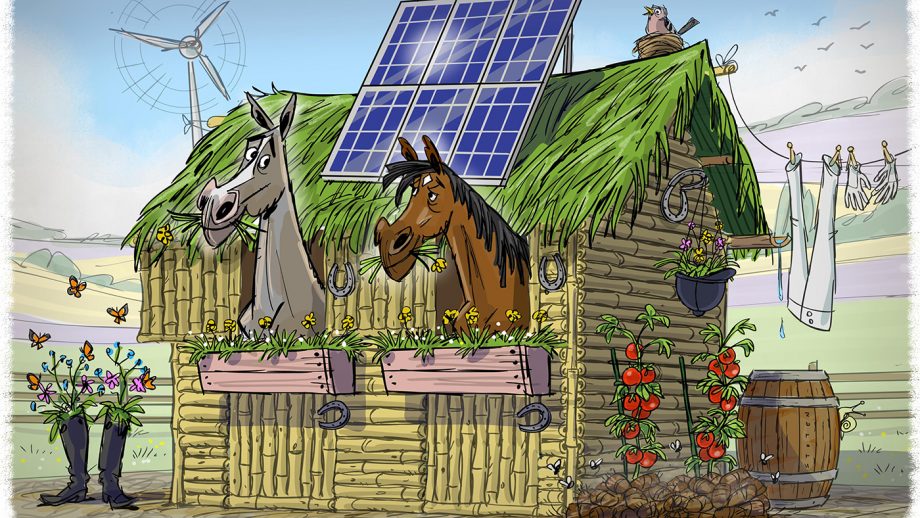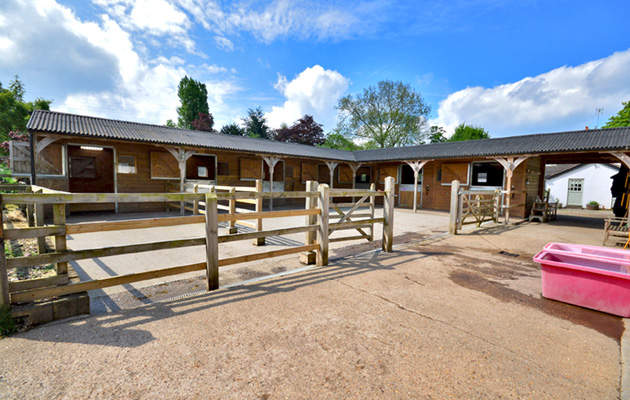Stephanie Bateman investigates how to build or adapt stables on a low carbon footprint and why constructing a yard need not be a drain on the environment
Not a day goes by when the words “eco-friendly” or “sustainable” don’t make it into conversation, and rightly so. But the good news for those building or improving their stable yard is that there are plenty of ways we can reduce our negative impact on the environment.
“Whether you are designing a yard from scratch or making adjustments to an older yard, there are designs and materials that can improve sustainability and reduce your carbon footprint,” says Scott Green, business development manager of The Stable Company.
“We take sustainability very seriously and only use timber from suppliers that are FSC [Forest Stewardship Council] certified, giving us and our clients peace of mind that the buildings we provide are sourced responsibly. We are also mindful that the products we use reach the required structural requirements without over-engineering the buildings and wasting timber during installation.”
For the stables’ base, concrete is traditionally used. “Concrete can have a high carbon footprint, so we encourage our clients to look into new products to reduce the amount of concrete needed,” adds Scott. “For example, products such as the HippoTile flooring system reduce the amount of concrete and bedding required.”
Scott also advises clients to investigate other options, such as recycling rainwater. “We have had a number of clients who use rainwater-harvesting tanks to store the water and reuse around the yard, plus auto-drinkers save on water wastage,” he says. “We design our buildings to withstand the weight of solar panels or solar hot water systems, and we have used wind power and battery storage for people who are off the grid and want to reduce their carbon footprint. Changing lights to LED is another big eco-friendly save.”
The benefits of wood
In terms of construction materials, wood has a multitude of benefits.
“Today’s timber products combine the qualities of a natural resource with the high performance of modern building materials,” says James Scott, managing director of Scotts of Thrapston. “Timber is a natural insulator, so in the summer stables remain cooler and they keep warmer in the winter months.
“When it is sustainable and responsibly sourced, there is a positive impact on climate change, too. Wood requires CO2 to grow and, therefore, becomes a key part in the defence against climate change,” James continues. “Sourcing wood from sustainably managed forests helps encourage biodiversity, increases forestation and maximises CO2 absorption.”
Wood also delivers on speed, cost and resource efficiency. “It is a much more eco-friendly option than brick or block-built stables and, due to fewer deliveries thanks to being relatively lightweight and transportable, it promotes cleaner roads,” advises James.
In the yard design process, James advises that the layout should include landscaped areas to break up areas of concrete and tarmac.
“This is so that the water can drain naturally and remove the pressure from your drainage system which, if overwhelmed, can cause flooding.”
Eco-friendly tiles are also becoming increasingly popular. “We offer tiles that are made from recycled plastic and others that are fully recyclable,” says James. “It’s also worth considering installing sun pipes to allow more natural lighting into the building, and careful planning of the layout could include larger storage areas to minimise numbers of deliveries to the yard when it comes to bedding and forage.”
For stabling flooring, products such as HippoTile are in favour. HippoTile is made from 100% recycled plastic and allows wet to drain away, which ultimately results in reduced carbon emissions.
“Using comparative figures for one 12x12ft stable, the HippoTile floor creates over 80% less carbon dioxide than the concrete floor,” explains HippoTile’s creator Janet Warner.
“Because a HippoTile floor is warmer, more forgiving and kinder to joints, less bedding is required to create a comfortable bed. And, because it allows urine and water to drain through it, less bedding is discarded which not only saves money, but has a positive environmental impact, too.”
A thriving equestrian property
It’s not just stable manufacturers doing their bit for the environment. Dickie Waygood, British Equestrian Federation (BEF) performance director, bought a run-down house with land 11 years ago and, over the years, has gradually built it up into a thriving equestrian property, with an indoor stable barn, horse walker and arena.
“I was stone broke, so I had to come up with ingenious solutions to build what I wanted with no money,” he said. “My barn is from Cheval Liberté, which was delivered on hundreds of wooden pallets which I used to build shelves, saddle racks and bridle hooks in the tack room as well as an internal ceiling in the barn for storage and an outside shed to house the batteries for the solar panels located on the groom’s flat roof.”
Dickie did a lot of the work himself, laying the concrete and putting up buildings to save money and reduce his carbon footprint.
“I also collect rainwater to wash the horses and dirty kit with, which reduces my water usage,” he adds.
Event rider William Fox-Pitt rents an Archimedean screw hydro turbine, which is situated in a river two miles from their property. “It generates electricity which we sell to the grid to offset the electricity we use,” says William’s wife, Alice.
“We have solar panels on the indoor school roof, which power the yard; and our muck from the stables is spread on the farmland.”
Alice is also looking into ways to reduce plastic waste. “We use a milk station down the road and a company supplies us with canned water for the lorry,” she says. “We are also in talks with innovative recycle firm TerraCycle about coming up with a way of recycling the baler twine, haylage wrap and shavings bags, but that’s a work in progress.”
First published in Horse & Hound; 9 April 2020
You may also be interested in…

How green is your yard? 6 budget-busting eco-friendly solutions
Eco-friendly design can be incorporated into everything from light bulbs to storage solutions — and it could save you money

Loose boxes or American barns? H&H investigates the pros and cons

Safe, eco-friendly and budget-friendly: H&H’s stable lighting tips
Does your stable and arena lighting system need an overhaul? Check out H&H’s top tips on the best and safest

A horse on the roof? You’re not hallucinating, we promise
Pinch yourself: this yard is for real. Set in the ‘Pampas’ region of Argentina, this futuristic set-up is the home

Subscribe to Horse & Hound magazine today – and enjoy unlimited website access all year round




